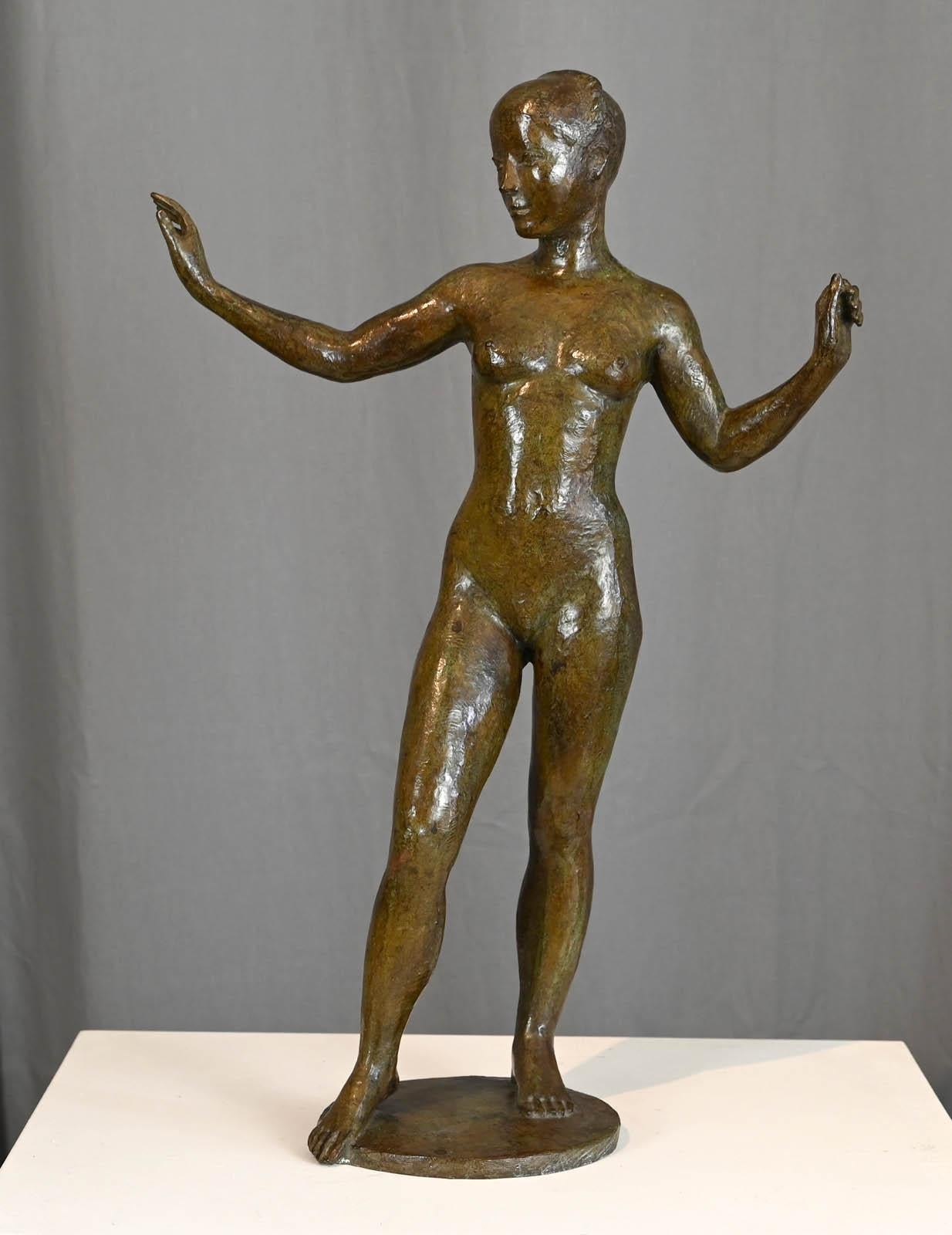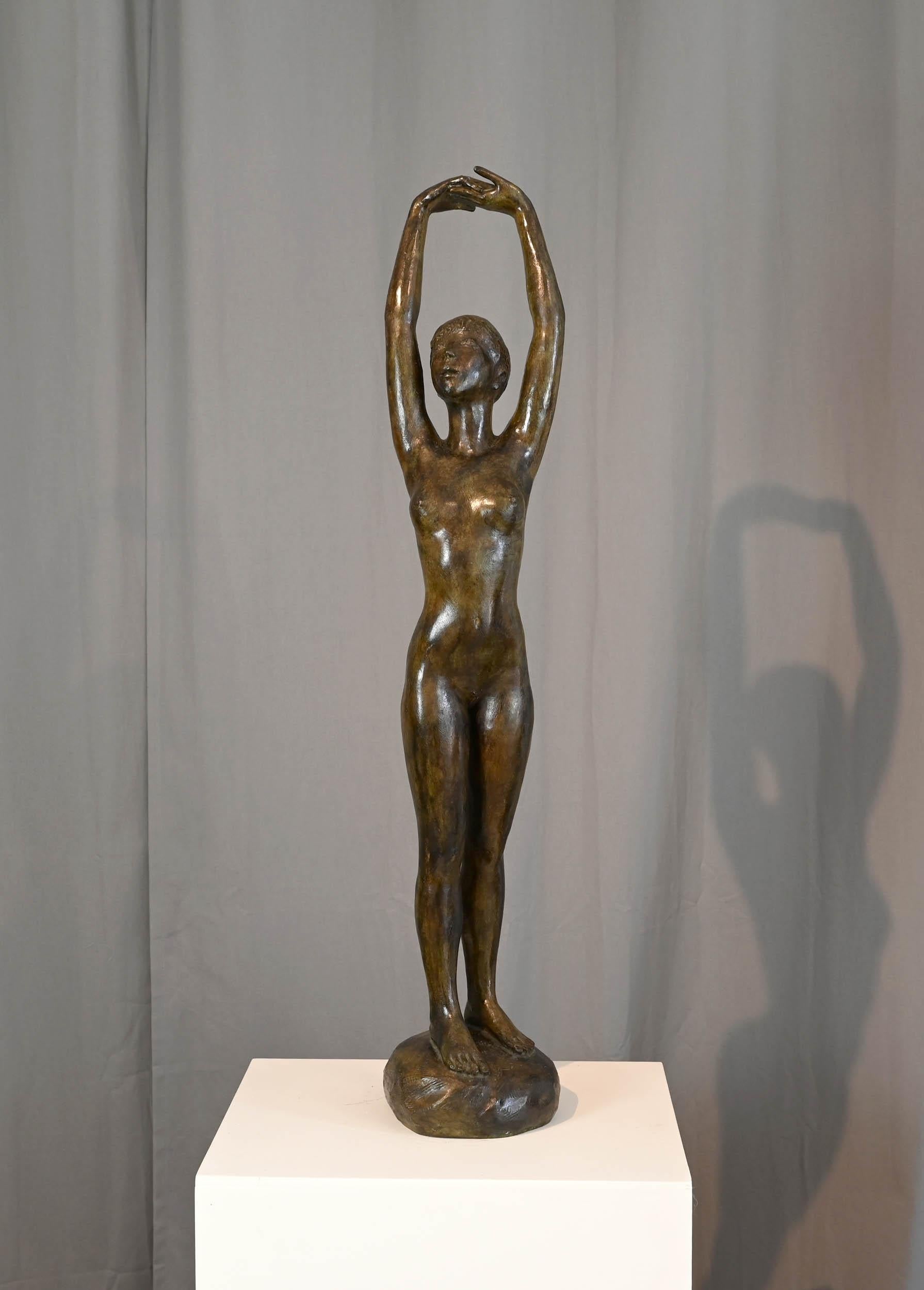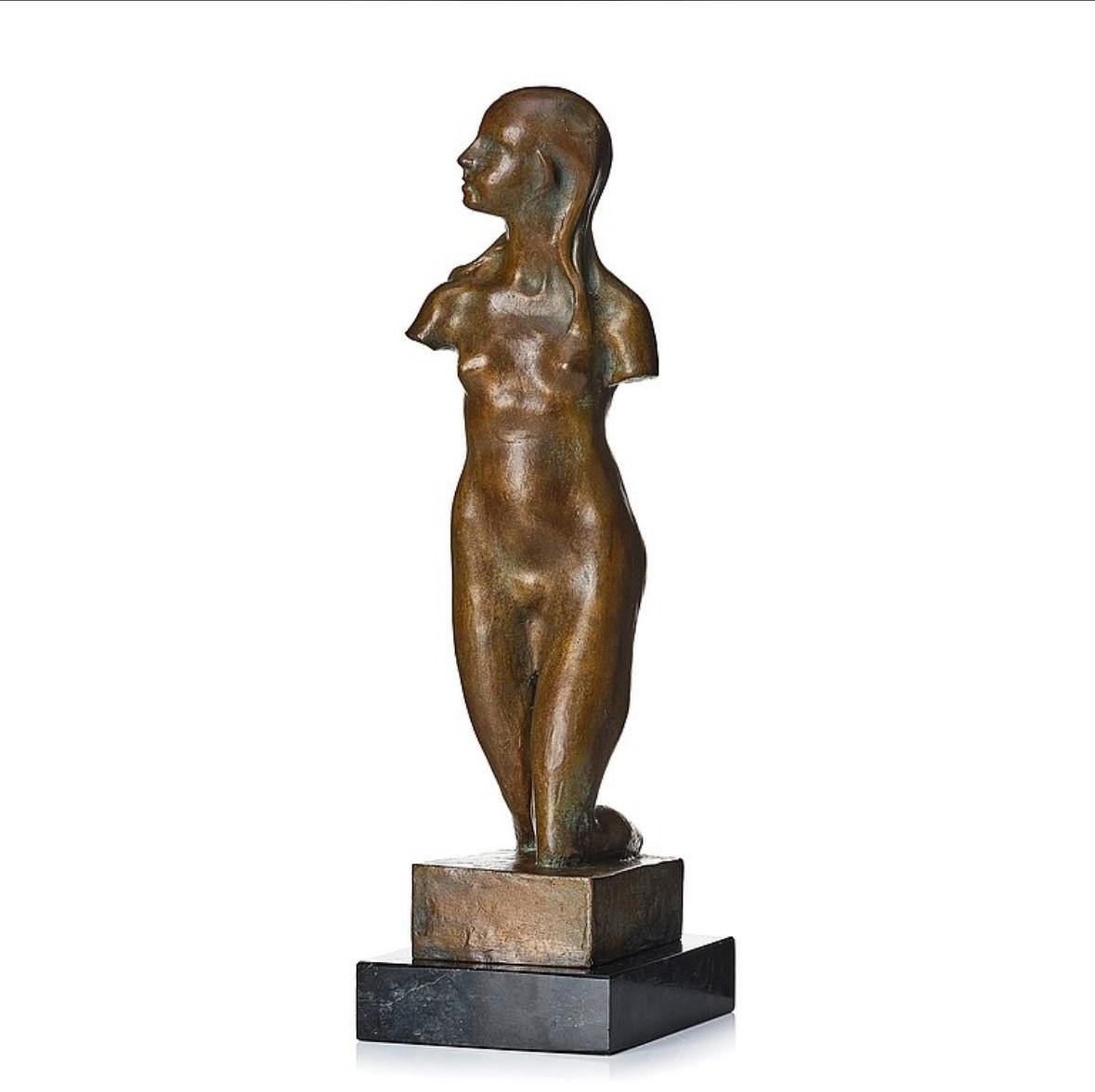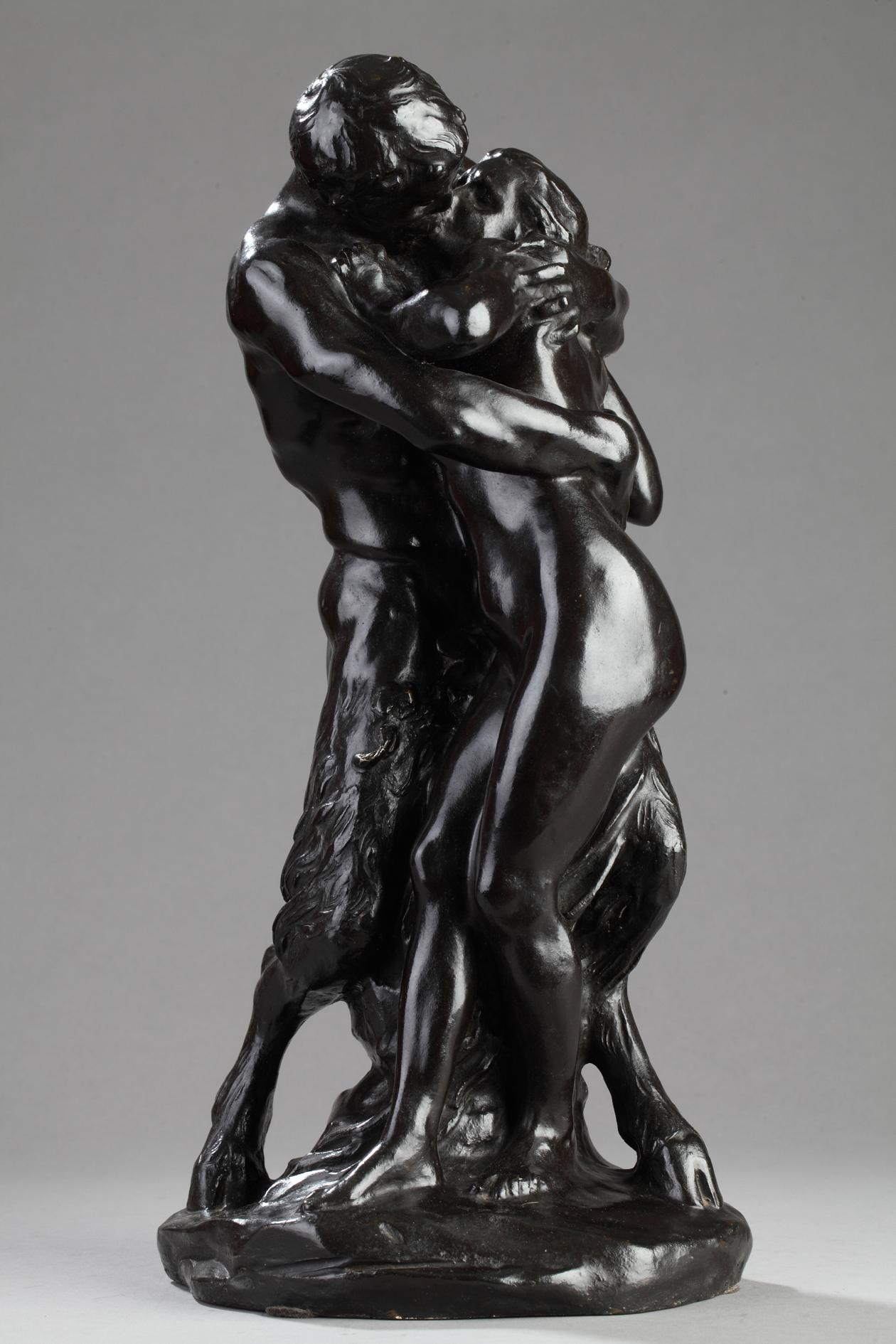Want more images or videos?
Request additional images or videos from the seller
1 of 9
James PradierWoman taking off her shirt
About the Item
Woman taking off her shirt
by James PRADIER (1790-1852)
Bronze with a nuanced brown patina
cast by SOYER and INGE
France
circa 1850
height 28,5 cm
Biography :
Jean-Jacques Pradier, known as James Pradier (1790-1852) was a sculptor and painter from Geneva who made a career in France. Following the fashion of the time, he adopted the English name of "James". He entered the public school of drawing in 1804. In 1807 he joined his brother Charles-Simon Pradier in Paris, where he worked for François-Frédéric Lemot before being admitted to his studio at the Ecole des Beaux-Arts in Paris, as well as in the painters Charles Meynier and François Gérard.
Pradier won the Grand Prix of Rome in 1813 in sculpture for his bas-relief "Néoptolème prevents Philoctète to pierce Odysseus with his arrows". He was appointed professor of sculpture at the School of Fine Arts in Paris in 1828, where he replaced François-Frédéric Lemot. We wanted to recognize the traits of Juliette Drouet, his mistress, in the marble group Satyr and Bacchante who caused a scandal at the Salon of 1834. This link ended when Juliette met Prince Demidoff, she left for Victor Hugo, then Pradier's friend. In Paris, James Pradier had in 1831, his home rue des Beaux-Arts and his studio at rue Neuve-de-l'Abbaye.
- Creator:James Pradier (1790 - 1852)
- Dimensions:Height: 11.23 in (28.5 cm)Width: 4.73 in (12 cm)Depth: 2.76 in (7 cm)
- Medium:
- Movement & Style:
- Period:
- Condition:
- Gallery Location:PARIS, FR
- Reference Number:

About the Seller
5.0
Vetted Seller
These experienced sellers undergo a comprehensive evaluation by our team of in-house experts.
Established in 1992
1stDibs seller since 2023
Typical response time: 20 hours
- ShippingRetrieving quote...Ships From: PARIS, France
- Return PolicyA return for this item may be initiated within 3 days of delivery.
More From This SellerView All
- Snake CharmerBy Albert-Ernest Carrier-BelleuseLocated in PARIS, FRBronze sculpture with a nuanced dark brown patina signed on the base "A. Carrier" inscribed on a front plaque "Charmeuse de Serpents par Carrier-Belleuse" France circa 1860 height 80,5 cm Biography : Albert-Ernest Carrier de Belleuse known as Carrier-Belleuse (1824-1887) was one of the most prolific artists of the century and had the greatest successes under the Second Empire, enjoying the personal support of Napoleon III. His work was greatly influenced by the style of the Italian Renaissance and that of the 18th century, which he helped to bring up to date. In 1837, the young Carrier-Belleuse apprenticed in the workshop of the engraver Bauchery. He was admitted soon after to the goldsmith Jacques Henri Fauconnier. Through François Arago, he met the sculptor David d'Angers who facilitated his admission to the School of Fine Arts. Carrier-Belleuse entered it in 1840. Noted for his skill by the great bronze companies in Paris such as Barbedienne and Denière, he soon received numerous orders for models for candelabras, pendulums, fittings for fireplaces, etc. In 1848, probably at the initiative of François Arago, who became head of state, he received his first public order for a small statue of "Mademoiselle Rachel singing La Marseillaise". In 1851, he appeared for the first time at the Salon of French Artists, where he presented two bronze medallions. From 1851 to 1855, Carrier-Belleuse stayed in England, in Stoke-on-Trent where he served as director of the modeling and drawing school of the Minton house, a large porcelain manufacturer. Back in France, Carrier-Belleuse moved to Paris in a large workshop located 15 rue de la Tour d´Auvergne. From 1857, he made regular sendings to the Salon and became famous thanks to the success of large marbles, such as the "Bacchante" exhibited at the Salon in 1863, and acquired by Napoleon III, "Angelica" (1866) or even "Hebe asleep" (1869). At the Salon of 1867, his group entitled "Messiah" earned him the medal of honor of sculpture. It was acquired by the State to adorn the Chapel of the Virgin in the Saint-Vincent-de-Paul church. Carrier-Belleuse acquired a great reputation in parallel for his terracotta busts which, in many respects, recall those of 18th century artists. He made portraits of a large number of celebrities of his time. He produced, among others, the busts of Napoleon III, Renan, Thiers, Grévy, Arago, Marguerite Bellanger, Théophile Gautier, Honoré Daumier, Delacroix, Hortense Schneider, Réjane… He also modelled numerous busts of mythological inspiration and historical and artistic portraits like Marie Stuart, Shakespeare or even Mozart. Carrier-Belleuse used and trained in his workshop in the rue de la Tour d´Auvergne many young talented artists such as Alexandre Falguière, Jules Desbois...Category
1860s French School Figurative Sculptures
MaterialsBronze
- The ComedyLocated in PARIS, FRPierre-Marie POISSON (1876-1953) The Comedy Bronze sculpture with black patina signed on the base "P. Poisson" Cast by Valsuani (with the foundry stamp) Raised on a stone base Fra...Category
1930s French School Figurative Sculptures
MaterialsBronze
- The KissBy Aimé-Jules DalouLocated in PARIS, FRThe Kiss also named "Nymph and Faun" by Jules DALOU (1838-1902) A bronze group with a black patina Signé "Dalou" A very fine cast by "A.A. Hébrard" (with the foundry stamp) The ca...Category
Early 1900s French School Figurative Sculptures
MaterialsBronze
- Diana with an arrowBy Albert-Ernest Carrier-BelleuseLocated in PARIS, FRDiana with an arrow by Albert-Ernest CARRIER-BELLEUSE (1824-1887) Bronze sculpture with a dual light and dark brown patina signed on the base "Carrier-Belleuse" inscribed on a front plaque "Diane à la Flèche par Carrier-Belleuse (Sculptr)" France circa 1870 height 83 cm arrow added probably in the 20th c. Biography : Albert-Ernest Carrier de Belleuse known as Carrier-Belleuse (1824-1887) was one of the most prolific artists of the century and had the greatest successes under the Second Empire, enjoying the personal support of Napoleon III. His work was greatly influenced by the style of the Italian Renaissance and that of the 18th century, which he helped to bring up to date. In 1837, the young Carrier-Belleuse apprenticed in the workshop of the engraver Bauchery. He was admitted soon after to the goldsmith Jacques Henri Fauconnier. Through François Arago, he met the sculptor David d'Angers who facilitated his admission to the School of Fine Arts. Carrier-Belleuse entered it in 1840. Noted for his skill by the great bronze companies in Paris such as Barbedienne and Denière, he soon received numerous orders for models for candelabras, pendulums, fittings for fireplaces, etc. In 1848, probably at the initiative of François Arago, who became head of state, he received his first public order for a small statue of "Mademoiselle Rachel singing La Marseillaise". In 1851, he appeared for the first time at the Salon of French Artists, where he presented two bronze medallions. From 1851 to 1855, Carrier-Belleuse stayed in England, in Stoke-on-Trent where he served as director of the modeling and drawing school of the Minton house, a large porcelain manufacturer. Back in France, Carrier-Belleuse moved to Paris in a large workshop located 15 rue de la Tour d´Auvergne. From 1857, he made regular sendings to the Salon and became famous thanks to the success of large marbles, such as the "Bacchante" exhibited at the Salon in 1863, and acquired by Napoleon III, "Angelica" (1866) or even "Hebe asleep" (1869). At the Salon of 1867, his group entitled "Messiah" earned him the medal of honor of sculpture. It was acquired by the State to adorn the Chapel of the Virgin in the Saint-Vincent-de-Paul church. Carrier-Belleuse acquired a great reputation in parallel for his terracotta busts which, in many respects, recall those of 18th century artists. He made portraits of a large number of celebrities of his time. He produced, among others, the busts of Napoleon III, Renan, Thiers, Grévy, Arago, Marguerite Bellanger, Théophile Gautier, Honoré Daumier, Delacroix, Hortense Schneider, Réjane… He also modelled numerous busts of mythological inspiration and historical and artistic portraits like Marie Stuart, Shakespeare or even Mozart. Carrier-Belleuse used and trained in his workshop in the rue de la Tour d´Auvergne many young talented artists such as Alexandre Falguière, Jules Desbois...Category
1870s French School Nude Sculptures
MaterialsBronze
- Young woman seated with draperyLocated in PARIS, FRYoung woman seated with drapery by Pierre-Marie POISSON (1876-1953) Bronze sculpture with nuanced green patina signed on the base "P. Poisson" old cast France circa 1935-40 height...Category
1930s French School Nude Sculptures
MaterialsBronze
- BatherLocated in PARIS, FRBather by Etienne Hachenburger (19th-20th C.) Sculpture in white Carrara marble Signed on the side of the base "E. Hachenburger" A simiilar model was exhibited at the Paris Salon oh...Category
Early 1900s French School Nude Sculptures
MaterialsMarble
You May Also Like
- MarieLocated in LE HAVRE, FRJacques COQUILLAY (né en 1935) Marie Original bronze Size : 56x39x17cm Copy No. 4/8 Signature and numbered on the base. Original bronze made with ...Category
Early 2000s French School Nude Sculptures
MaterialsBronze
- VictoireLocated in LE HAVRE, FRJacques COQUILLAY (né en 1935) Victoire Original bronze Size : 105 x 22 x 20 cm Copy No. 1/8 Signature and numbered on the base. Original bronze m...Category
Early 2000s French School Nude Sculptures
MaterialsBronze
- Female torsoLocated in Täby, SEGunnar Knut Nilsson, born 1904 in Karlskrona, died 1995 in Versailles in France, was a Swedish sculptor. Gunnar Nilsson studied watercolor painting and modeling at the Technical Vocational School in Karlskrona in 1918-19 and on his own in addition to working as a clerk at Finspångs Metallwerk. His debut exhibition was in Finspång in 1927. With the help of a local fundraiser, and after the encouragement of Carl Eldh, he traveled to Paris in 1928 to study sculpture for, among others, Charles Despiau and Paul Niclausse. In Paris he socialized with Bror Hjorth, whose former studio he also rented, Carl Frisendahl and Alberto Giacometti. He came to belong to "Le groupe des Neuf'' with Paul Cornet...Category
1950s French School Nude Sculptures
MaterialsBronze
- Lying Body by Sergio Monari 1985 Figurative Sculpture Patinated Bronze CastBy Sergio MonariLocated in Brescia, ITBronze artwork made with lost wax casting technique. This is the prototype, unique signed artist proof. Sergio Monari is an Italian sculpture, that liv...Category
1980s Post-Minimalist Figurative Sculptures
MaterialsBronze
- 1985 Figurative Sculpture Patinated Bronze Cast Sergio MonariBy Sergio MonariLocated in Brescia, ITBronze artwork made with lost wax casting technique. This is the prototype, unique signed artist proof. Title "Sleeping body" Sergio Monari is an Italia...Category
1980s Post-Minimalist Figurative Sculptures
MaterialsBronze
- Crouched Body by Sergio Monari 1985 Figurative Sculpture Patinated Bronze CastBy Sergio MonariLocated in Brescia, ITBronze artwork made with lost wax casting technique. This is the prototype, unique signed artist proof. Sergio Monari is an Italian sculpture, that lives and works in Bologna, Italy. He exhibited his artworks in the best Galleries...Category
1980s Post-Minimalist Figurative Sculptures
MaterialsBronze
Recently Viewed
View AllMore Ways To Browse
Antique Wanted
Marble Group
Marble Sculpture Nude
Antique Bronze Nude
Antique Nude Bronze
Antique Bronze Sculpture Woman
Bronze Nude Woman
Relief Nude
Nude Woman Bronze Sculpture
James A Rome
Shirt Sculpture
Antique Marble Nude
James Brown Sculpture
Woman Shirt
Arrow Sculpture
French Marble Sculpture Woman
Cast Arrow
Bas Relief In Marble



